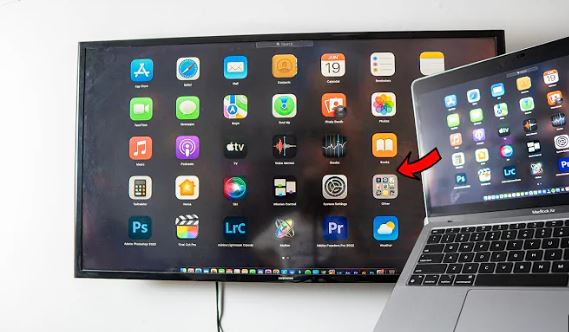How to Share Your MacBook Screen (Without a Fuss!)
Introduction
Greetings, my fellow Macbook lovers! Are you tired of fumbling around with cords and adapters just to share your screen with others? Well, fret no more! In this comprehensive guide, we’ll explore the effortless ways to share your MacBook screen, so you can collaborate and present like a pro.
AirDrop: The Wireless Wonder
Wirelessly Send Files and Screens
AirDrop is the most convenient method for sharing your MacBook screen with other Apple devices. Simply activate AirDrop on both devices and select the “Share Screen” option. Your screen will be instantly mirrored on the receiving device, allowing for seamless collaboration and presentations.
Multiple Recipients Support
AirDrop’s versatility extends to sharing your screen with multiple recipients simultaneously. Whether it’s a group project or a virtual meeting, you can easily select the desired recipients and broadcast your screen to all of them at once.

Screen Casting: Extend Your Reach
Connect to External Displays
Screen casting allows you to extend your MacBook’s display to an external monitor or projector. This is ideal for presentations, conferences, or when you simply need a larger screen to work with. Simply connect your MacBook to the external display using an HDMI or DisplayPort cable, and select the “Mirror Display” option in the System Preferences.
Enhance Video Conferencing
Screen casting comes in handy during video conferences when you want to share specific content or applications with participants. By casting your screen to the video conferencing platform, you can easily present slides, demonstrate software, or collaborate with remote team members as if they were in the same room.
Third-Party Apps: Specialized Solutions
Remote Desktop Access
While AirDrop and screen casting cover most sharing scenarios, third-party apps offer specialized features for advanced screen sharing needs. Remote desktop apps, such as TeamViewer and Splashtop, allow you to remotely control your MacBook from another device, providing remote support or presentations.
Screen Recording and Editing
Screen recording apps, such as QuickTime Player and OBS Studio, enable you to capture and record your screen activity, including audio and webcam footage. These apps are ideal for creating video tutorials, demonstrations, or showcasing your work to others.
Table: Comparison of Screen Sharing Methods
| Method | Features | Pros | Cons |
|---|---|---|---|
| AirDrop | Wireless, multiple recipients | Convenient, fast | Limited to Apple devices |
| Screen Casting | External displays, video conferencing | Large screen extension | Requires physical connections |
| Remote Desktop Access | Remote control, presentations | Advanced features, cross-platform support | Requires additional software, potential security concerns |
| Screen Recording and Editing | Screen capture, video creation | Versatility, educational purposes | Requires additional setup, large file sizes |
Conclusion
There you have it, Macbook lovers! With these effortless methods, you can confidently share your MacBook screen with others for presentations, collaborations, and remote support. Whether you prefer the convenience of AirDrop, the extended reach of screen casting, or the specialized features of third-party apps, there’s a solution to suit every need. So go ahead, embrace the world of screen sharing and elevate your productivity and collaboration to new heights.
Don’t forget to check out our other insightful articles for more tips and tricks to maximize your MacBook experience:
- [5 Hidden Features of Your MacBook That Will Change Your Life](link to article)
- [How to Optimize Your MacBook Battery Life for Maximum Productivity](link to article)
- [Mastering the Trackpad: Advanced Gestures for Your MacBook](link to article)
FAQ about Sharing Your MacBook Screen (Without a Fuss!)
How do I share my MacBook screen wirelessly?
Share your screen via AirPlay to an Apple TV or another Mac by clicking the Screen Mirroring icon in the menu bar.
How do I share my MacBook screen with a projector?
Connect your MacBook to the projector using an HDMI or USB-C cable adapter. Then, go to System Preferences > Displays and select the projector as the AirPlay display.
How do I share my MacBook screen with another computer?
Use a screen-sharing app like ScreenFlow, Reflector, or AirServer. Or, if you have a Mac and another Apple device, you can use Sidecar.
Can I share my MacBook screen with multiple devices?
Yes, you can use AirPlay to simultaneously share your screen with multiple Apple TVs, Macs, and other AirPlay-compatible devices.
How do I stop sharing my MacBook screen?
Click the AirPlay icon in the menu bar and select “Turn Off Mirroring.”
What do I do if I can’t see the AirPlay icon?
Make sure the device you want to share with is on the same Wi-Fi network and is compatible with AirPlay. If that doesn’t work, try restarting your devices.
Why is my shared screen laggy or flickering?
Ensure there’s a strong Wi-Fi signal between your MacBook and the receiving device. If possible, connect both devices to the same Wi-Fi network using an Ethernet cable.
How do I share a specific window or app on my MacBook screen?
Use the “Share Window” option in AirPlay or a third-party screen-sharing app. Select the window or app you want to share from the list.
Can I share my MacBook screen with a Windows PC?
Yes, you can use a third-party screen-sharing app that supports both macOS and Windows, such as Join.me or Zoom.
How do I share a portion of my MacBook screen?
Use a screen-sharing app like OBS Studio or Screencast-O-Matic. These apps allow you to define a custom cropping area to share only a specific part of your screen.
